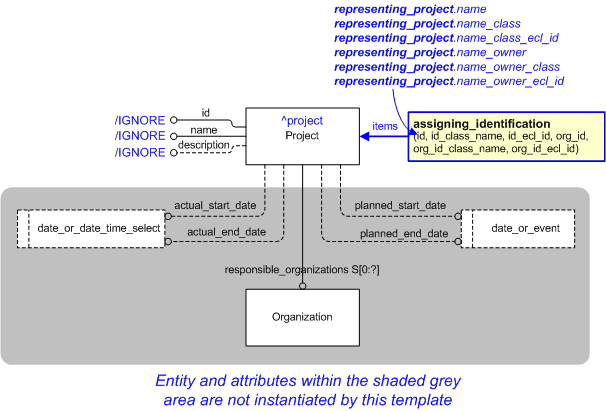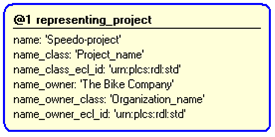Template:— representing_project (rep_proj)
Capability:representing_project_information |
Date: 2011/04/26 14:55:30
Revision: 1.3
|
This section specifies the template representing_project.
NOTE
The template has been defined in the context of the capability
representing_project_information
which provides an overall description of the
relevant parts of the ISO 10303-239 information model and a description
of related templates.
NOTE
An explanation of a template and the associated instantiation path is
provided in the
Template overview
section.
This template describes how to represent a project.
The EXPRESS-G diagram in
Figure
1
shows the templates and EXPRESS entities that are required
to represent the template
"representing_project".
The text highlighted in blue shows the template parameters.
Figure 1 — An EXPRESS-G representation of the Information model for representing_project
The graphic for the template to be used in other EXPRESS-G diagrams
is shown in Figure
2
below.
Figure 2 — The graphical representation of the representing_project template
The following input parameters are defined for this template:
The name or identifier of the
Project .
The name of the class being used to classify the
Project name or identifier (@name).
The following classes and their sub-classes can be used:
The identifier of the
External_class_library
storing the definition of the class referenced by the parameter @name_class.
The name or identifier of the organization owning the project name/identifier.
The name of the class being used to classify the
identification of the organization. For example CAGE code, or organization name.
The following classes and their sub-classes can be used:
The id of the
External_class_library
storing the definition of the class referenced by the parameter @name_owner_class.
The following reference parameters are defined for this template:
Allow the
Project
entity instantiated in this path to be referenced when this template is used.
Note: The
Project
entity can be referenced in a template path by:
%^target = $representing_project.project%
where
target
is the parameter to which the
Project
is bound.
The following parameter combinations specify a uniqueness constraint:
Unique constraint: Project
Each instance of the
entity
(
Project)
within the data set shall be uniquely identified
by a combination of the following parameters on this
template (representing_project) namely:
name,
name_class,
name_class_ecl_id,
name_owner.
The
instance is
referenced by the following template parameter:
project.
The instantiation path shown below specifies the entities that are to be
instantiated by the template.
A description of templates and the syntax for the instantiation path is
provided in the
Templates Help/Information section.
The following entities are instantiated with attributes as specified:
The instance diagram in Figure
3
shows an example of the EXPRESS entities and templates that are instantiated by the template:
/representing_project(name='Speedo-project', name_class='Project_name', name_class_ecl_id='urn:plcs:rdl:std', name_owner='The Bike Company', name_owner_class='Organization_name', name_owner_ecl_id='urn:plcs:rdl:std')/
(an illustration of the consolidated representing_project template is shown in
Figure
4 below.)
Figure 3 — Entities instantiated by representing_project template
The instance model in STEP ASCII exchange file format (ISO 10303 Part
21 syntax) is:
#2 = PROJECT('/IGNORE','/IGNORE','/IGNORE',(),$,$,$,$);
#4 = IDENTIFICATION_ASSIGNMENT('Speedo-project','/IGNORE','/IGNORE',(#2));
#6 = CLASSIFICATION_ASSIGNMENT(#7,(#4),'/IGNORE');
#7 = EXTERNAL_CLASS('/NULL','Project_name','/IGNORE',#8);
#8 = EXTERNAL_CLASS_LIBRARY('urn:plcs:rdl:std','/IGNORE');
#11 = ORGANIZATION('/IGNORE','/IGNORE');
#13 = IDENTIFICATION_ASSIGNMENT('The Bike Company','/IGNORE','/IGNORE',(#11));
#15 = CLASSIFICATION_ASSIGNMENT(#16,(#13),'/IGNORE');
#16 = EXTERNAL_CLASS('/NULL','Organization_name','/IGNORE',#8);
#18 = ORGANIZATION_OR_PERSON_IN_ORGANIZATION_ASSIGNMENT(#11,'/IGNORE',(#4));
#20 = CLASSIFICATION_ASSIGNMENT(#21,(#18),'/IGNORE');
#21 = EXTERNAL_CLASS('/NULL','Owner_of','/IGNORE',#8);
The instance diagram in
Figure
4
shows the graphic symbol for the template that is to be
used in other instance diagrams. The example template is:
/representing_project(name='Speedo-project', name_class='Project_name', name_class_ecl_id='urn:plcs:rdl:std', name_owner='The Bike Company', name_owner_class='Organization_name', name_owner_ecl_id='urn:plcs:rdl:std')/
Figure 4 — Instantiation of representing_project template
Characterizations
No common characterizations of the template
representing_project
have been identified. However, the ISO 10303-239 EXPRESS model
may enable other assignments to the entities instantiated by the template.




